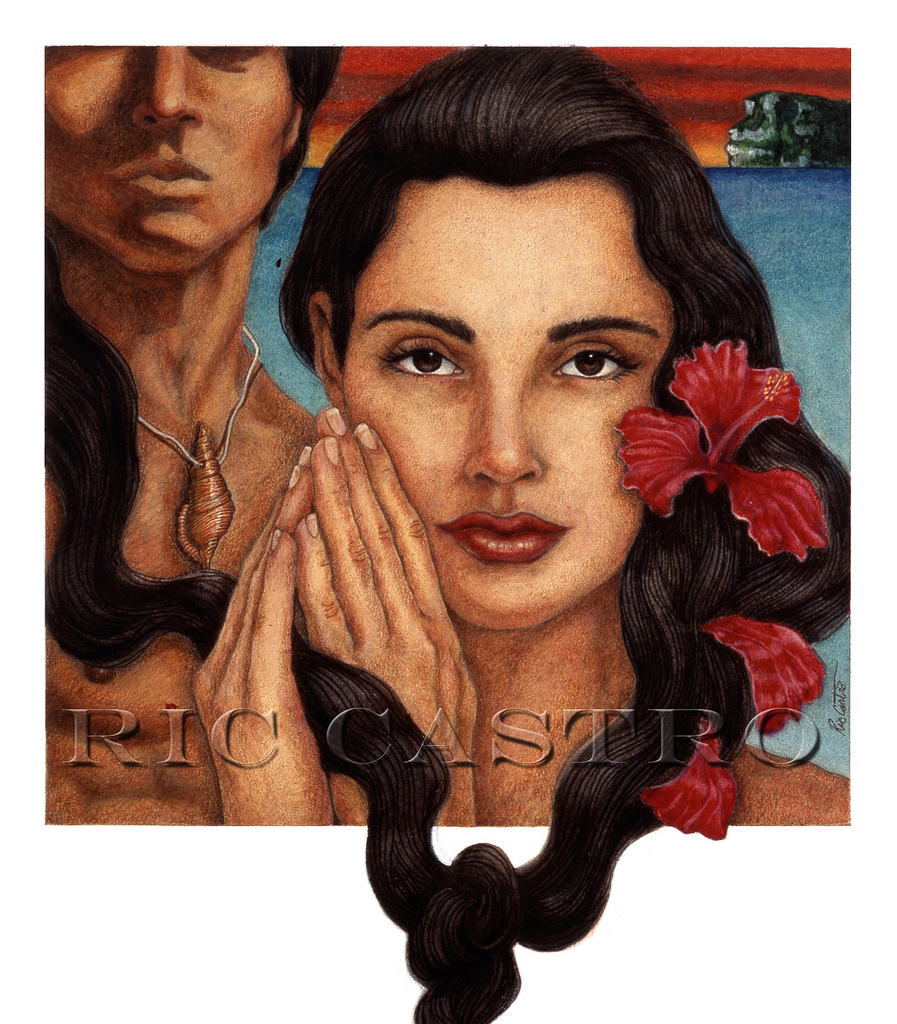Folktale: Puntan Dos Amantes
Table of Contents
Share This
Roles change over time

The story of the two lovers who tied their hair together and leapt to their death on Guam was first recorded by French researcher Louis Claude de Freycinet in 1819. Over the years various versions of the story have come to light. The story tells of two Chamorros/CHamorus who loved each other but their love was unacceptable because he was a high caste man (matao) and she a lower caste woman (manachang). Mataos were strictly forbidden from allying themselves with those from the lower caste.
A certain matao of the village of Gnaton fell in love with a young and pretty manachang girl and fled with her. He found no asylum among another native group, however, as he refused to part with her.
Pursued by his relatives, the young lovers wandered for some time in the most inaccessible wood and rocky areas; but so precarious and wretched an existence reduced them to despair. Determined to put an end to it, they built a tomb of stones and place in it the infant that was the sad fruit of their love.
Then, lost and distracted, they climbed to the very summit of a high, steep-sided peak beside the sea. Binding themselves together by the hair, and clasping one another, they cast themselves from that peak into the waves below.
The cape was named by the Spanish, Cabo de los Amantes (Lovers’ Cape), now known as Puntan Dos Amantes (Two Lover’s Point). After visiting Guam in 1819 Freycinet used the two lover’s story to emphasize the indelible connection between marriage and the traditional caste system in Chamorro society.
Since then the story has changed to include a Spanish figure. The story is best know as follows:
Once, long ago, during a time when Spain claimed the Mariana Islands, there was a family who lived in Hagåtña, the capital city of Guahan. The father was a wealthy Spanish businessman and the mother, a daughter of a great maga’låhi or Chamorro chief. This family owned much land and were highly respected by Chamorros and Spanish alike.
Their oldest daughter was a beautiful young woman, admired by all for her honesty, modesty, and natural charm. One day, as was Spanish custom, the girl’s father arranged for her to take a powerful Spanish captain as her husband. When the girl discovered this, she was so distraught that she ran from Hagåtña all the way to the north of Guahan until she found a secluded and peaceful shore.
There, on the moonlit shore, she met and fell in love with a young man from a modest Chamorro family. He was gentle, with a strong build and eyes that searched for meaning in the stars.
She returned home with a promise to see him again.
When the girl’s father learned of the two lovers, he grew angry and demanded that she marry the Spanish captain at once. However, that day at sundown, she stole away to the same high point along the shore, and once again met her Chamorro lover.
Her father, the captain and all the Spanish soldiers pursued the lovers up to the high cliff above Tomhom (Tumon) Bay. The lovers found themselves trapped between the edge of the cliff and the approaching soldiers. All the young man could do was warn them to stay back. The father ordered the soldiers to halt.
The lovers tied their long black hair together into a single knot. Acting as if they were entirely alone, they looked deeply into each other’s eyes and kissed for the final time. Then they leaped over the long, steep cliff into the roaring waters below. Her father and all who remained rushed to the edge and stared in great anguish at the ocean below.
The lovers were gone, never to be seen again.
Today the place where they jumped is known as Puntan dos Amåntes or Two Lover’s Point. Visitors still pay homage there to great love.
For further reading
Aguon, Baltazar B. I Dos Amantes: The Two Lovers. Self-published, 2005.
Freycinet, Louis Claude Desaulses de. An Account of the Corvette L’Uraine’s Sojourn at the Mariana Islands, 1819. Translated by Glynn Barratt. Saipan: Commonwealth of the Northern Mariana Islands Division of Historic Preservation, 2003.
